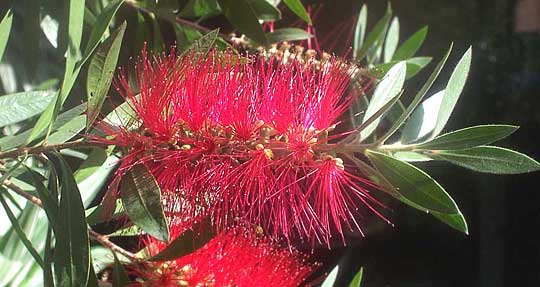Adapted from Jim Conrad's Naturalist Newsletter of August 10, 2007
issued from Sierra Gorda Biosphere Reserve,
QUERÉTARO, MÉXICO
THE BEAUTIFUL-STAMEN BUSH
Next to a bank along Avenida de La Reforma in Mexico City I snapped the photo shown below:

That a flowering branch the head-high Lemon Bottlebrush, CALLISTEMON CITRINUS, a member of the Myrtle Family, along with eucalyptuses, Allspice and of course myrtles. The genus name Callistemon derives from the Greek roots calli for "beauty," and stemon for "stamen" -- "beautiful stamens."
In fact, in the picture, the bright red, slender items so curiously arising in mid-stem are mostly the male stamens composed of red, stemlike filaments atop which reside tiny, pollen-producing anthers. Inside each stamen cluster there's a similar-looking slender, red style (the necklike extension of the ovary) and atop each style there's a tiny stigma, which is were pollen grains from other flowers germinate.
Especially in the picture's top stamen-clusters you can distinguish the single styles because they rise a tiny bit above the stamens, are a little thicker than the stamens' filaments, and their yellowish stigmas are flat-topped platforms instead of baglike anthers releasing pollen. The style is longer than the filaments because the flower "wants" the approaching pollinator to deposit pollen from other flowers on its stigma before entering the tuft of stamens below searching for nectar.
Crushed leaves of this plant have a distinctly citrus aroma. Native to Australia but planted worldwide, you can imagine how this species attracts hummingbirds.